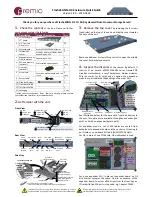
Hardware installation for Synchronous Mirroring
and Asynchronous Mirroring
The Asynchronous Mirroring feature uses a remote point-in-time replication method. Asynchronous
Mirroring differs from Synchronous Mirroring in one essential way: it captures the state of the source
volume at a particular point in time and includes just the data that has changed since the last image
capture. With Asynchronous Mirroring, the remote storage array is not fully synchronized with the
local storage array, so if the operation needs to transition to the remote storage array due to a loss of
the local storage array, some transactions could be lost.
The Synchronous Mirroring feature is also used for online, real-time data replication between storage
arrays over a remote distance. The storage array controllers manage the mirror operation. You create
one or more mirrored pairs consisting of a primary volume at the local site and a secondary volume at
a secondary, remote site. However, instead of batching the synchronization process using point-in-
time snapshot images like in Asynchronous Mirroring, the primary volume copies all of the data from
the primary volume to the secondary volume in a single operation. This full synchronization process
takes longer to complete, but creates a complete copy of the mirrored data. While this process is ideal
for certain operations, make sure you fully understand both data mirror options before selecting one
over the other.
See to the online help system for more information about the Synchronous Mirroring feature and the
Asynchronous Mirroring feature, and for software-related procedures to set the configuration of these
features and use them.
Planning and site preparation
The Asynchronous Mirroring feature can be used with either Fibre Channel or iSCSI connections.
Mirroring requires a duplex controller configuration. The Synchronous Mirroring feature can be used
only with Fibre Channel connections. For Fibre Channel connections, you
must have Fibre Channel
switches to create a fabric environment for data replication. For iSCSI connections, switches are
optional. The following restrictions apply to connections for Asynchronous Mirroring or
Synchronous Mirroring.
•
SAS and InfiniBand connections are not supported.
•
iSCSI connections must use a host-connect port and not the management Ethernet port.
With the Asynchronous Mirroring feature, the following considerations apply for combining Fibre
Channel and iSCSI connections:
•
If two storage arrays are connected through both Fibre Channel and iSCSI connections, only one
connection type is used for a given asynchronous mirror group. However, if there are multiple
asynchronous mirror groups, some asynchronous mirror groups can use Fibre Channel
connections while others use iSCSI connections.
•
Failover from a Fibre Channel connection to an iSCSI connection (or vice versa) is not supported.
Switches require only minimal additional site preparation beyond basic storage array operation. For
additional site preparation considerations for switches, including power requirements and physical
dimensions, refer to the documentation that is provided by the switch manufacturer.
iSCSI connections for Asynchronous Mirroring
You can use iSCSI connections for the Asynchronous Mirroring feature. Connect one iSCSI port on
each controller of the local (primary) storage array to the corresponding controller on the remote
109
Summary of Contents for StorNext QD7000
Page 1: ...Hardware Cabling Guide StorNext QD7000 Firmware 8 40 xx xx 6 68683 01 Rev A...
Page 7: ...Preface Hardware Cabling Guide vii...
Page 10: ...E Series Hardware Cabling Guide December 2017 215 11792_B0 doccomments netapp com...
Page 11: ......
Page 90: ...One E5660 controller drive tray and one DE6600 drive tray Drive shelf or drive tray cabling 81...
Page 106: ...One E2760 controller drive tray and one drive tray Drive shelf or drive tray cabling 97...
















































